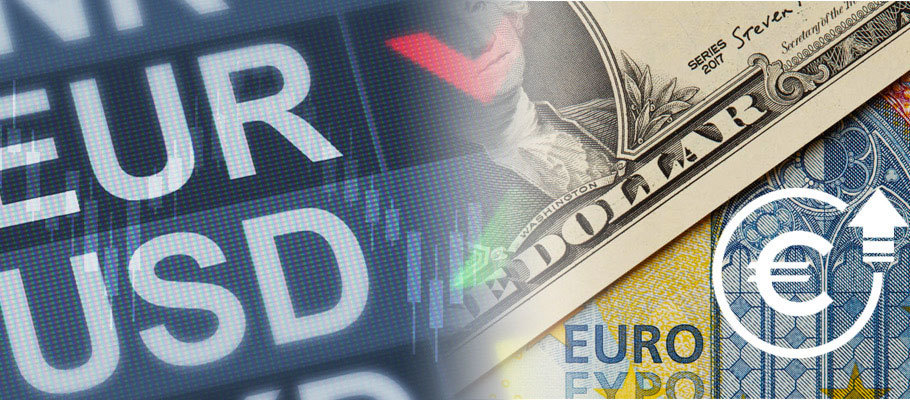
Published: April 12th, 2023
EUR/USD is set for a higher rate in the near term, with analysts at Bloomberg suggesting the pair will gain enough momentum to pierce resistance in the coming days.
The Euro to Dollar rate aimed for the 1.10 handle on Tuesday, 11th April after the long Easter weekend. However, it fell roughly 28 pips short before settling back under 1.09 in early European trading.
At time of writing it was level at 1.0900, however analysts believe a breakthrough is imminent, pointing to recent US data that’s raised the spectre of recession in the world’s largest economy.
European prints have been mostly sunny in recent weeks, providing the ECB with enough contrast against the US Fed to carry on its rate-hiking timeline and wrestle core inflation to the ground.
The forecast is based on improving data out of Germany. The Eurozone’s biggest economy looks as though it will escape recession while a weakening US labour market could cool any hawkish sentiment by UD Fed officials. With those dynamics behind it, EUR/USD could see constructive price action as this week’s session continues.
The EUR/USD rate has been trending higher since establishing a key support level around 1.05 in mid-March. The Euro’s ascent has been steady, leading to stability for the pair above the 21-day exponential moving average, where key support has held at around 1.0800.
That's a reversal from late February, when EUR was on the back foot against the Greenback.
An upward adjustment to the terminal rate and cooling rate cut expectations for later in 2023 spurred new life into USD at the start of the year. Rising investor expectations about the timing of the Federal Reserve's peak interest rate hiking cycle also added wind to the Dollar’s sails.
In January, consensus had the last rate rise set for March, but an additional two hikes were then added to the table. The likelihood of a Fed rate cut in the latter part of 2023 had receded, giving the Dollar support after an underwhelming end to 2022 and beginning to 2023.
EUR/USD looked set to hit 1.10 in January but had fallen back by early February as new US economic data flummoxed analysts, who sent mixed signals into the market.
A surprising mix of strong wage data, labour market dynamics, inflation figures and retail sales suggested the American economy was robust enough to achieve the Fed’s above-target inflation levels. EUR/USD started to retrace previous gains as a result.
Analysts at Barclays Forex Strategy Unit said ‘Stronger American growth data blended with firmer inflation at the beginning of 2023 added optimism to markets. Forex traders are now pricing-in a more hawkish outlook for Fed policy’.
Looking back to April of 2022, spiking oil prices were pushing the Euro toward multi-year lows as forex traders bet that the European Central Bank would delay plans to raise interest rates later in the year.
Prices for Brent Crude surged above USD 130 per barrel in March 2022, the highest level for almost 13 years. Wholesale gas prices meanwhile more than doubled from the previous month on fears that the US and EU were considering an unequivocal ban on Russian oil.
The US did move forward with plans to ban purchases of Russian oil and gas, with other G7 countries following suit. European natural gas prices responded by hitting an all-time high.
In a note to investors, the FX Strategy unit at Crédit Agricole wrote that news of major Western importers considering coordinated sanctions against Russian energy exports sent oil and other commodity prices soaring, especially in Asia.
‘Conjecture around ramped up sanctions in the energy sector has started with a bang. Stocks have tumbled and crude prices are soaring on Asian markets as traders' price-in the impact of a US and EU ban on Russian crude supplies’.
In response to the supply shock, Crédit Agricole said a ‘binary move’ in currency markets was underway, one that favoured the fiats of energy exporting countries. Net energy importing countries, in contrast, would see their currencies take a hit.
In a weekly currency research briefing note, Barclays said at the time that the Ukraine conflict had delivered a negative EUR shock.
‘In the near term, the Euro has scope to trade lower given the potential stagflation effect on the Eurozone. Looking further ahead, the war could compel more structural integration by member states that provides EUR with support.’
The Pound to Euro exchange rate reached 1.2177 on Tuesday 8th March, the highest level since June 2016. The Euro to Dollar rate dipped to 1.0857, the lowest level since April 2020.
Economists thought surging oil and gas prices would drag the Eurozone economy down due to its reliance on Russian gas and oil. BMO Capital Markets European FX Strategy unit said that a negative relationship would strengthen between the price of crude oil and EUR/USD.
‘We believe forex traders will devote significant time this week to watching how these variables play out. The risk of an all-out EU ban on Russian oil imports will be one of the most important factors hanging over EUR/USD.’
There were also concerns in the market that a dip in Eurozone economic growth could see the ECB cool enthusiasm for its planned post-COVID normalisation of monetary policy. A change in course might have limited Eurozone bond yields and pulled the Euro down further.
'Rising prices for commodities across the board could force central banks to slam the brakes on interest rate rises. That’s impacting EUR sentiment,’ said BMO.
As the Ukraine conflict hotted up, Kiev put pressure on the EU to ban imports of Russian oil, with the country’s foreign minister pleading with the EU Parliament to wean Europe off of energy imports that are ‘paid for with Ukrainian sacrifices’.
– Mark de Wolf for FX-List